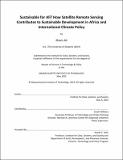Sustainable for All? How Satellite Remote Sensing Contributes to Sustainable Development in Africa and International Climate Policy
Author(s)
Ali, Ilham
DownloadThesis PDF (6.315Mb)
Advisor
Williams, Sarah
Terms of use
Metadata
Show full item recordAbstract
Satellite remote sensing applications are among the most important technological and data tools available to sustainable development practitioners today but are still underutilized. Sustainable development is multidimensional and characterized by many factors such as environmental sustainability, economic livelihoods, social dynamics, etc. – most of which satellites have a role in supporting. In this work, satellite contributions to the United Nations Sustainable Development Goals are robustly quantified using a novel impact classification method, and recommendations are given for key expansions of satellite remote sensing use in Africa from disease reduction of malaria and cholera, to implementation of social protection mechanisms for the poor at scale, to expansion of urban greenspace connectivity, and more. The domestic African satellite industry is also evaluated in the context of its capacity development and data policies. African satellite launches have grown significantly in recent years making up 62% of all ‘rest of world’ satellite launches in 2019 and with approximately 20 nations having established national space agencies through 2021. Small satellites, and nanosatellites in particular, have featured as many new entrant nations’ debut satellites due to their modularity and utility. Room for improvements exist in increasing data usage and availability from successful missions, particularly with the new coordination capacities of the regional African Space Agency. Finally, blended data processing methods combining satellite environmental data and geospatial population data are used to illustrate water futures in East Africa. Predictive modeling and feature selection on the dataset were also able to detect El Niño effects in 2015 and connect rising heat levels and groundwater availability to climate-influenced micro-mobility patterns. This work highlights the importance of satellite data for serving small to medium-sized urban agglomerations in particular (<100,000), where the majority of Africa’s urban population lives but are difficult to reach with in-situ methods. Policy recommendations are given in the context of the Paris Climate Agreement to integrate satellite data-based methods for realization of the Warsaw loss and damage mechanism and to spur implementation action to protect vulnerable nations and populations.
Date issued
2022-05Department
Massachusetts Institute of Technology. Institute for Data, Systems, and SocietyPublisher
Massachusetts Institute of Technology